Traditional Angled Leg Barstool Frame
Build a Traditional Barstool Frame with a Round or Square Seat!
Barstools are super-easy to build and there are so many variations! I needed a traditional angled leg barstool frame for a DIY project (more on that below!) and created simple barstool plans so that any shape desired can be added to the frame as a seat. The top of the legs require cutting compound angle (an angle sloping in two directions) but if you’re not comfortable with that sort of advanced math, don’t sweat it! The angles are so minor that a shim can be used under the piece for the seat to fill the gap. But if you’re game to try – DO IT!
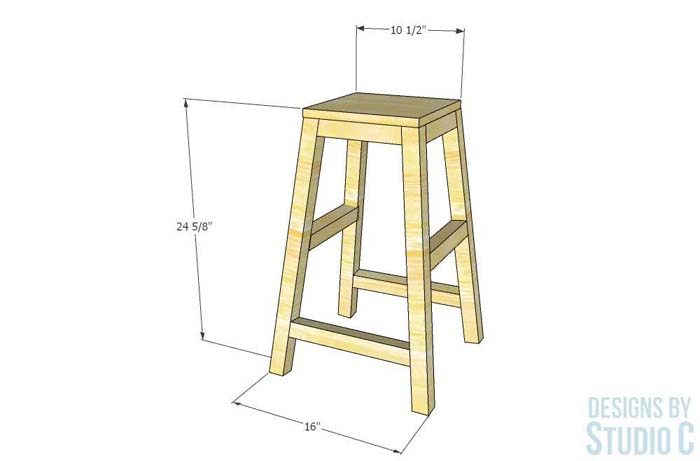
The depth and width of the frame can also be changed by changing the length of the stretchers, as well as the size of the seat. This particular stool is pretty narrow as I needed it to fit under a couple of plastic chair seats. The frame is incredibly steady so if you like it being narrow, the seat can be wider and overhang, if desired!
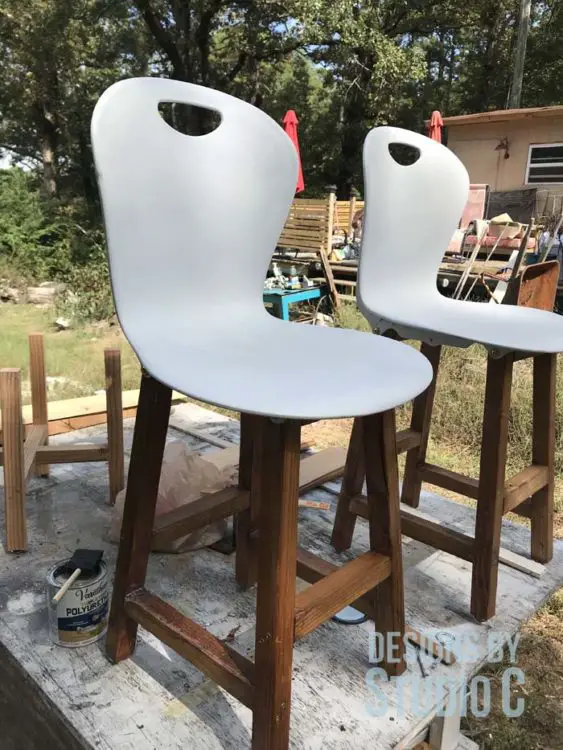
Materials:
- 2-1/2″ screws
- 3″ Powerlag screws (for decorative use, if desired) (<– affiliate link!)
- Wood glue
- Finishing supplies
Lumber:
To make TWO barstool frames:
- 4 – 2×2 at 8′
Cut List:
- 8 – 2×2 at 24-3/8″ – Legs
- 4 – 2×2 at 12-1/16″ – Lower Stretchers
- 4 – 2×2 at 10-1/4″ – Middle Stretchers
- 8 – 2×2 at 7-7/8″ – Upper Stretchers
Optional Seat:
- 3/4″ plywood at 10-3/8″ x 10-1/2″ OR
- 3/4″ plywood at 15″ diameter
Notes About the Project:
- I built my frames to attach to the bottom of two plastic chair seats that I had, and used the Powerlags to attach the seat to the frame
- I left the bottom of the legs square and used nail-on feet for angled legs (<– affiliate link!) on the bottom
- I also left the top of the legs square because in my project, it didn’t matter – the frame is attached to the underside of a plastic chair seat
Step One
Cut the pieces for the legs to length. Select two adjoining faces of each leg to be the outside – the compound angles will slope up and away from this corner edge. Draw a diagonal line on each of the two faces (see the drawing below) starting at 3/16″ below the top of the leg at the corner. These lines will be the reference to cut the 6.5° compound angles. The angles are totally optional, though! (Shims can be used to fill the gap when attaching the seat.)

Step Two
Cut the pieces for the lower stretchers at 12-1/16″ long with a 6.5° angle at each end. The pieces can either be attached using countersunk screws from the outside of the leg, or pocket holes – your choice! (I used countersunk screws) Don’t forget the glue! The stretchers are positioned 4″ up from the bottom of the leg. Make FOUR of these assemblies.

Step Three
Cut the pieces for the middle stretchers at approximately 10-1/4″ long with a 6.5° angle at each end. The middle stretchers will be positioned approximately 12″ up from the bottom of the leg and secured in the same manner as the lower stretchers with glue and screws. Two of these pieces will join two of the leg assemblies to make one frame.
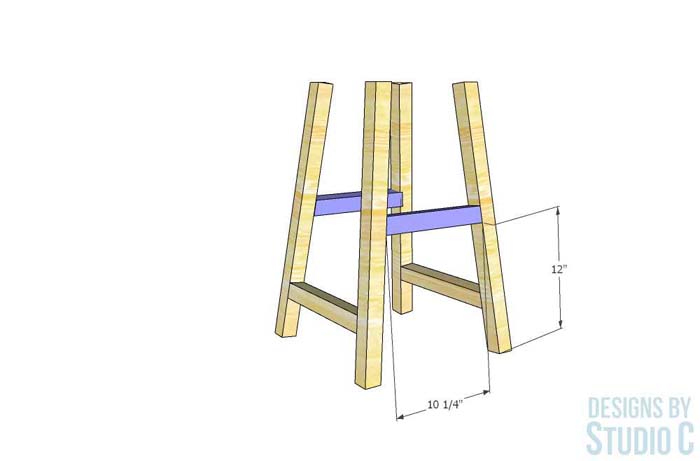
With my DIY barstools, I had to make the leg assemblies with the lower stretcher, then have a helper hold the legs upright so that I could measure the distance between the legs, 12″ up from the bottom or work surface, for the middle stretchers. If the pieces are cut at 10-1/4″ as I outlined above, the barstool will be slightly rectangular.
Step Four
Cut the pieces for the upper stretchers at approximately 7-7/8″ long with a 6.5° angle at each end. Secure the pieces to the legs using glue and screws, but make sure the screws won’t interfere with each other on the adjoining side.
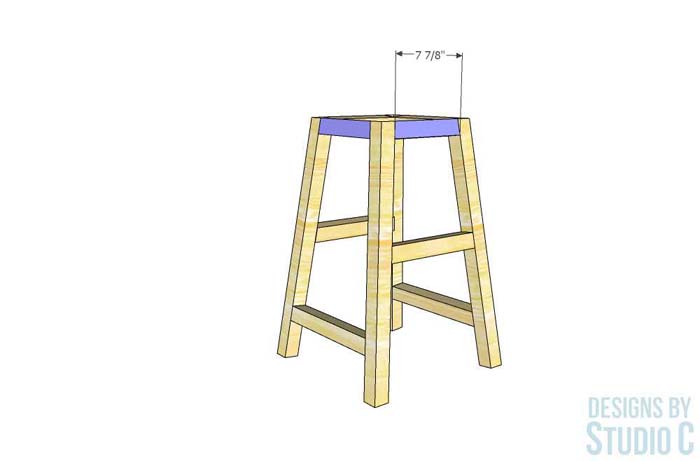
The Seat:
Measure the top of the frames for a seat. If using a rectangular piece, it should measure approximately 10-3/8″ x 10-1/2″ with no overhang. The seat can be secured using screws through the top of the seat into the legs, by securing cleats to the inside of the upper stretchers and driving screws through the underside of the cleats into the seat, or by using pocket holes drilled into the upper stretchers.
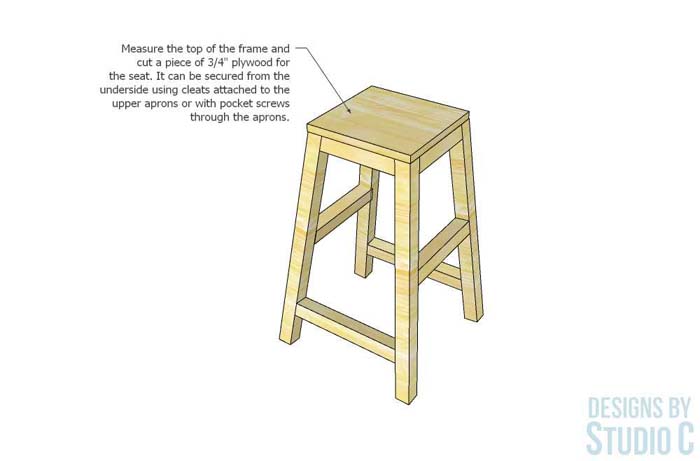
The seat can be made larger, if desired, or circular by measuring the distance between legs diagonally. Other options for the seat can be upholstery or even attaching another seat that has lost its legs, like I did! Here’s mine:
I spray painted the chair seat white…

I stained the legs using Golden Oak stain (I love the golden oak stain on pine!!), then finished with two coats of polyurethane.


I added the nail-on furniture feet to the bottom of the frame before I secured the seats.

Then I attached the seats using the Powerlag screws. I chose the Powerlags because they have a washer-type head and would hold the seats firmly in place. (Hint: the head of the Powerlags can be spray painted for a decorative look!) Of course, the holes from the screws I used during assembly can be seen but only if you’re looking under the seat!


The only thing I would’ve done differently, is use the Powerlags or even pocket holes to attach the stretchers to the frame. Otheerwise, I love these stools, and they are incredibly comfortable!
Have questions about the traditional angled leg barstool frame? Leave a comment below – I’d be happy to help! Also, please share photos of your build!
Originally posted 2021-10-13 13:34:09.

